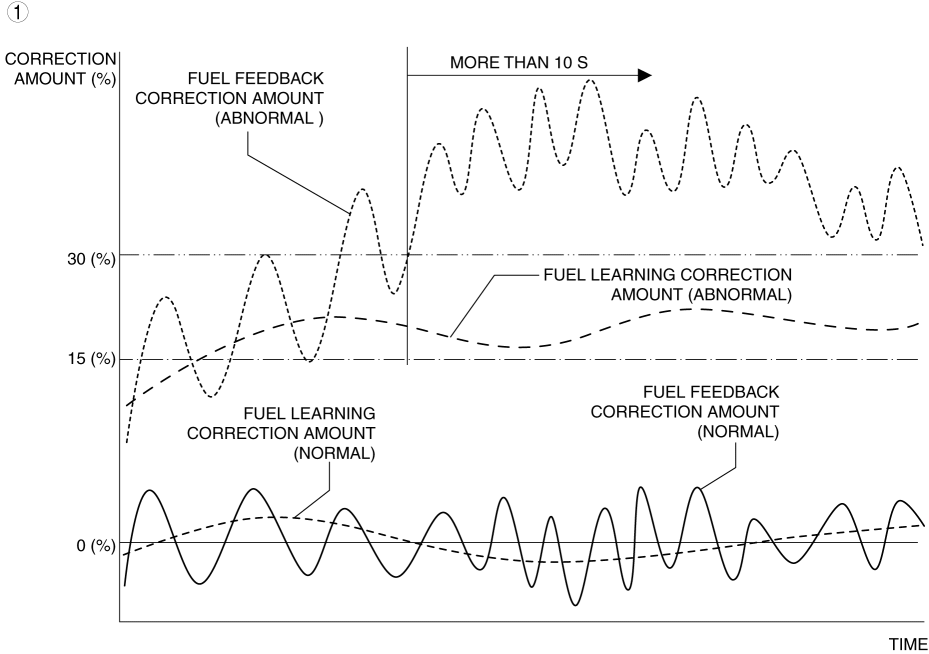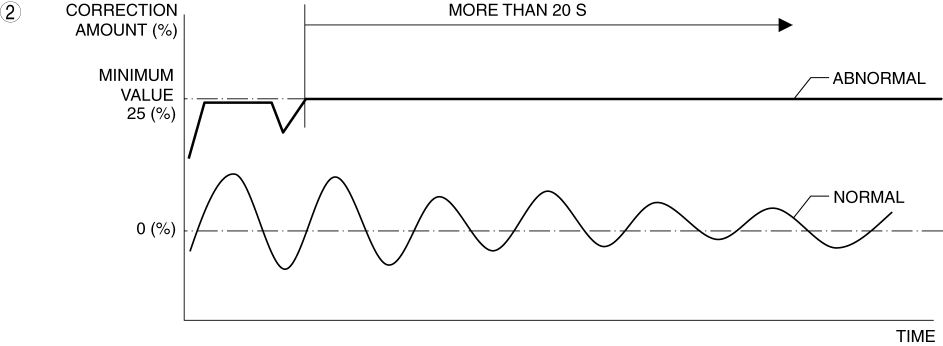|
|
| STEP | INSPECTION | RESULTS | ACTION |
| 1 | PURPOSE: VERIFY IF CAUSE OF MALFUNCTION IS RELATED TO LACK OF FUEL
| Yes | Refill the fuel, then go to Step 20. |
| No | Go to the next step. |
| 2 | PURPOSE: DETERMINE INTEGRITY OF FUEL PRESSURE SENSOR
| Yes | Replace the fuel distributor, then go to Step 20. (See FUEL INJECTOR REMOVAL/INSTALLATION [SKYACTIV-G 2.5].) |
| No | Go to the next step. |
| 3 | PURPOSE: DETERMINE INTEGRITY OF HIGH PRESSURE FUEL PUMP
| Yes | Replace the high pressure fuel pump, then go to Step 20. (See HIGH PRESSURE FUEL PUMP REMOVAL/INSTALLATION [SKYACTIV-G 2.5].) |
| No | Go to the next step. |
| 4 | PURPOSE: VERIFY IF MALFUNCTION RELATED TO FUEL LEAK FROM FUEL SYSTEM OR RESTRICTION AFFECTS DIAGNOSTIC RESULTS
| Yes | Repair or replace the malfunctioning part according to the inspection results, then go to Step 20. |
| No | Go to the next step. |
| 5 | PURPOSE: DETERMINE INTEGRITY OF FUEL PUMP CONTROL MODULE
| Yes | Replace the fuel pump control module, then go to Step 20. (See FUEL PUMP CONTROL MODULE REMOVAL/INSTALLATION [SKYACTIV-G 2.5].) |
| No | Go to the next step. |
| 6 | PURPOSE: DETERMINE INTEGRITY OF FUEL PUMP UNIT
| Yes | Replace the fuel pump unit, then go to Step 20. (See FUEL PUMP UNIT REMOVAL/INSTALLATION [SKYACTIV-G 2.5].) |
| No | Go to the next step. |
| 7 | PURPOSE: DETERMINE INTEGRITY OF FUEL INJECTOR
| Yes | Replace the fuel injector, then go to Step 20. (See FUEL INJECTOR REMOVAL/INSTALLATION [SKYACTIV-G 2.5].) |
| No | Go to the next step. |
| 8 | PURPOSE: DETERMINE INTEGRITY OF PURGE SOLENOID VALVE
| Yes | Replace the purge solenoid valve, then go to Step 20. (See PURGE SOLENOID VALVE REMOVAL/INSTALLATION [SKYACTIV-G 2.5].) |
| No | Go to the next step. |
| 9 |
| Yes | Replace the PCV valve, then go to Step 20. (See POSITIVE CRANKCASE VENTILATION (PCV) VALVE REMOVAL/INSTALLATION [SKYACTIV-G 2.5].) |
| No | Go to the next step. |
| 10 | PURPOSE: DETERMINE INTEGRITY OF MAF SENSOR
| Yes | Replace the MAF sensor/IAT sensor No.1, then go to Step 20. (See MASS AIR FLOW (MAF) SENSOR/INTAKE AIR TEMPERATURE (IAT) SENSOR NO.1 REMOVAL/INSTALLATION [SKYACTIV-G 2.5].) |
| No | Go to the next step. |
| 11 | PURPOSE: VERIFY IF MALFUNCTION RELATED TO AIR CLEANER ELEMENT AFFECTS MEASUREMENT OF INTAKE AIR AMOUNT
| Yes | Replace the air cleaner element, then go to Step 20. (See AIR CLEANER ELEMENT REMOVAL/INSTALLATION [SKYACTIV-G 2.5].) |
| No | Go to the next step. |
| 12 | PURPOSE: DETERMINE INTEGRITY OF MAP SENSOR
| Yes | Replace the MAP sensor/IAT sensor No.2, then go to Step 20. (See MANIFOLD ABSOLUTE PRESSURE (MAP) SENSOR/INTAKE AIR TEMPERATURE (IAT) SENSOR NO.2 REMOVAL/INSTALLATION [SKYACTIV-G 2.5].) |
| No | Go to the next step. |
| 13 | PURPOSE: VERIFY IF MALFUNCTION RELATED TO INTAKE AIR SYSTEM AFFECTS DIAGNOSTIC RESULTS
| Yes | Repair or replace the malfunctioning part according to the inspection results, then go to Step 20. |
| No | Go to the next step. |
| 14 | PURPOSE: DETERMINE INTEGRITY OF ELECTRIC VARIABLE VALVE TIMING DRIVER
| Yes | Replace the electric variable valve timing motor/driver, then go to Step 20. (See ELECTRIC VARIABLE VALVE TIMING MOTOR/DRIVER REMOVAL/INSTALLATION [SKYACTIV-G 2.5].) |
| No | Go to the next step. |
| 15 | PURPOSE: DETERMINE INTEGRITY OF ELECTRIC VARIABLE VALVE TIMING MOTOR
| Yes | Replace the electric variable valve timing motor/driver, then go to Step 20. (See ELECTRIC VARIABLE VALVE TIMING MOTOR/DRIVER REMOVAL/INSTALLATION [SKYACTIV-G 2.5].) |
| No | Go to the next step. |
| 16 | PURPOSE: DETERMINE INTEGRITY OF ELECTRIC VARIABLE VALVE TIMING ACTUATOR
| Yes | Replace the electric variable valve timing actuator, then go to Step 20. (See ELECTRIC VARIABLE VALVE TIMING ACTUATOR, HYDRAULIC VARIABLE VALVE TIMING ACTUATOR REMOVAL/INSTALLATION [SKYACTIV-G 2.5].) |
| No | Go to the next step. |
| 17 | PURPOSE: DETERMINE INTEGRITY OF OCV
| Yes | Replace the OCV, then go to Step 20. (See OIL CONTROL VALVE (OCV) REMOVAL/INSTALLATION [SKYACTIV-G 2.5].) |
| No | Go to the next step. |
| 18 | PURPOSE: DETERMINE INTEGRITY OF A/F SENSOR
| Yes | Replace the A/F sensor, then go to Step 20. (See AIR FUEL RATIO (A/F) SENSOR REMOVAL/INSTALLATION [SKYACTIV-G 2.5].) |
| No | Go to the next step. |
| 19 | PURPOSE: VERIFY IF MALFUNCTION RELATED TO EMISSION SYSTEM AFFECTS HO2S SIGNAL
| Yes | Repair or replace the malfunctioning part according to the inspection results, then go to Step 24. |
| No | Go to the next step. |
| 20 | PURPOSE: VERIFICATION OF VEHICLE REPAIR COMPLETION
| Yes | Repeat the inspection from Step 1.
Go to the next step. |
| No | Go to the next step. |
| 21 | PURPOSE: VERIFY IF THERE IS ANY OTHER MALFUNCTION
| Yes | Go to the applicable DTC inspection. (See DTC TABLE [SKYACTIV-G 2.5].) |
| No | DTC troubleshooting completed. |

